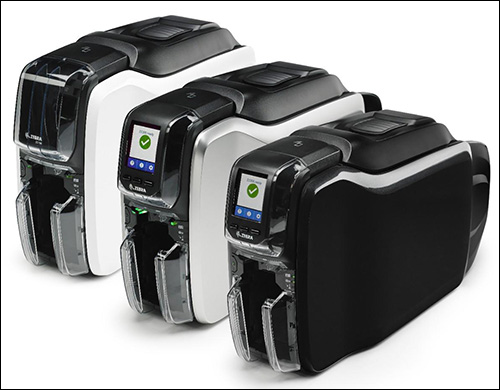Schools, exhibit planners, office complexes and other organizations are employing a new generation of intelligent card printers from Zebra Technologies that are designed to print and encode cards with high-frequency (HF) or low-frequency (LF) radio frequency identification. The new printers, known as the ZC300 and the ZC350, can operate with the company’s next-generation software (a companion product), known as CardStudio 2.0.
The new offering, released last month in parts of the world, is intended to make badge printing easier, while requiring a relatively small footprint. During the coming three to six months, Zebra expects to release an ultrahigh-frequency (UHF)-enabled version of the card printers as an additional option.
The new devices are already being used to print employee badges, student IDs, access-control cards, loyalty or membership cards, and event or seasonal passes. The ZC300 series (ZC300 and ZC350 models) comes with an option for built-in RFID encoders so users can create HF 13.56 MHz cards, says Annika Matas, Zebra’s senior product manager, while another new printer, the ZC100, is a lower-cost, entry-level version that is not RFID-enabled. Additionally, the printers can print LF cards, commonly known as proximity cards, which are pre-encoded.
The demand for RFID-enabled cards is growing, says Ram Ramaprasad, Zebra’s director of product management, as companies seek better, more efficient ways to provide access control, security, mustering and other functions that do not require visual inspection of cards. “What we’re seeing is a growing trend in adoption of RFID,” he states. Additionally, the printers are being used in hospitality, access control, mustering, event management and financial services.
The ZC300 and ZC350 versions are each designed to meet those requirements. The ZC300, expected to be released in the coming months, will be sold in all global regions and will not come with RFID encoding. The ZC350, meanwhile, is already being sold in North America, Europe, the Middle East and Africa. It comes with a built-in RFID encoder and operates with the CardStudio 2.0 software. The ZC300 series comes with an encoding option in Latin America and the Asia-Pacific region.
Moreover, the ZC350 includes three new ribbons for improved print quality. One ribbon extends the life of the image, while the other two offer other enhancements in terms of print quality and security. The printers all come with a color LCD screen and can support up to 10 languages. Companies can upgrade their printers if they want to print both sides of a badge. Resellers or solution providers are, in some cases, also employing Zebra’s Android-based software developers kit (SDK) for use with mobile devices. CardStudio 2.0, a Microsoft Windows-based application, does not require the SDK. The software platform manages the card-issuance process by integrating pictures from a webcam and prompting the printing of a smart card.
The latest generation of CardStudio software, Matas says, “helps to take our card-printing design to another level of simplicity,” such as by allowing a two-step process in which one user could design what is printed on the card, in the CardStudio software, while another could access that data and print the card. The ZC300-series printers, with RFID encoders, were designed to make the process easy, the company explains, and to create RFIID-enabled badges on demand or in batches.
When it comes to schools, Ramaprasad says, “Student identification has been a very important trend.” Many schools gain their state funding based on students’ daily attendance, and collecting attendance data has traditionally been a manual process that was time-consuming and error-prone. With the ZC300 printer and appropriate application software, a school could automatically capture this data.
First, a school would need to register each new student by entering his or her name and other identifying information, then take a picture with his or her own webcam, or one provided by Zebra. The picture and identification data can be stored on a cloud-based server, or simply be captured by the CardStudio-based software. In either case, the badge could then be printed, with the student’s picture and relevant information. This could be accomplished with each new student registration, or in batches before the school year starts. The card feeder adjusts automatically to the thickness of the card being printed. The school could then register each student’s attendance with an RFID reader deployed at the school or classroom entrance.
School badges are only one application for the printers. At trade shows, for instance, the software and printer could enable mobile badge printing. In such a scenario, users could employ an Android-based tablet to input data regarding an individual, such as an attendee at the show, or to scan a bar code to access that data; the tablet could also be used to take a photo of the individual. That information could then be forwarded to software on a cloud-based server, and sent to the printer to prompt the printing of a badge. Software could be supplied by a solution provider or the company using the printer.
Ski resorts company Vail Resorts is already utilizing Zebra’s ZXP Series 7 printer to print UHF RFID lift badges for its visitors to use for day or season passes. The lift badge includes a picture of the skier and an encoded UHF RFID tag built inside. When a badge passes a resort employee equipped with a handheld reader at the lift, the device can capture its tag ID through as many as five layers of clothing items, Ramaprasad says, and thereby provide access to that authorized user. Because the ZC300 series will be smaller, the resort intends to transition to using the new printers when the UHF RFID encoding functionality is available.
“What we offer today,” Matas says, “is a solution platform [including the printer and CardStudio 2.0 software] that is easy to deploy, and easy to operate and maintain.” While the ZC350 is already available in North America and EMEA, the ZC300 version, also with RFID encoding capabilities, is expected to be made available later this year in Latin America and the Asia-Pacific region.




